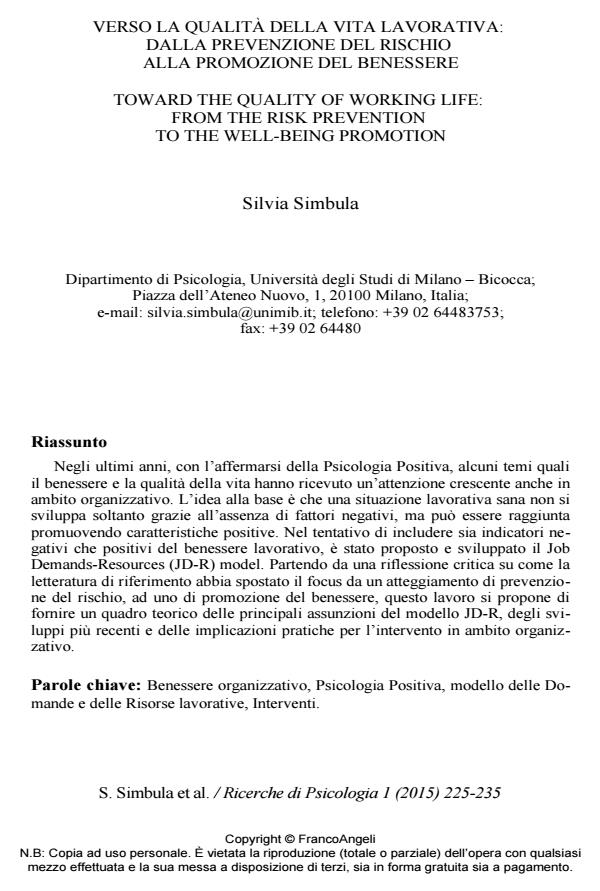Verso la qualità della vita lavorativa: dalla prevenzione del rischio alla promozione del benessere
Titolo Rivista RICERCHE DI PSICOLOGIA
Autori/Curatori Silvia Sumbula
Anno di pubblicazione 2015 Fascicolo 2015/1
Lingua Italiano Numero pagine 11 P. 225-235 Dimensione file 177 KB
DOI 10.3280/RIP2015-001014
Il DOI è il codice a barre della proprietà intellettuale: per saperne di più
clicca qui
Qui sotto puoi vedere in anteprima la prima pagina di questo articolo.
Se questo articolo ti interessa, lo puoi acquistare (e scaricare in formato pdf) seguendo le facili indicazioni per acquistare il download credit. Acquista Download Credits per scaricare questo Articolo in formato PDF

FrancoAngeli è membro della Publishers International Linking Association, Inc (PILA)associazione indipendente e non profit per facilitare (attraverso i servizi tecnologici implementati da CrossRef.org) l’accesso degli studiosi ai contenuti digitali nelle pubblicazioni professionali e scientifiche
Negli ultimi anni, con l’affermarsi della Psicologia Positiva, alcuni temi quali il benessere e la qualita della vita hanno ricevuto un’attenzione crescente anche in ambito organizzativo. L’idea alla base e che una situazione lavorativa sana non si sviluppa soltanto grazie all’assenza di fattori negativi, ma puo essere raggiunta promuovendo caratteristiche positive. Nel tentativo di includere sia indicatori negativi che positivi del benessere lavorativo, e stato proposto e sviluppato il Job Demands-Resources (JD-R) model. Partendo da una riflessione critica su come la letteratura di riferimento abbia spostato il focus da un atteggiamento di prevenzione del rischio, ad uno di promozione del benessere, questo lavoro si propone di fornire un quadro teorico delle principali assunzioni del modello JD-R, degli sviluppi piu recenti e delle implicazioni pratiche per l’intervento in ambito organizzativo.
Parole chiave:Benessere organizzativo, Psicologia Positiva, modello delle Domande e delle Risorse lavorative, Interventi
- Sono presente qui e ora, e sto bene! ? Il ruolo della mindfulness nel Job Demands - Resources Model Michela Vignoli, Gerardo Petruzziello, Dina Guglielmi, in PSICOLOGIA DELLA SALUTE 2/2016 pp.106
DOI: 10.3280/PDS2016-002006
Silvia Sumbula, Verso la qualità della vita lavorativa: dalla prevenzione del rischio alla promozione del benessere in "RICERCHE DI PSICOLOGIA " 1/2015, pp 225-235, DOI: 10.3280/RIP2015-001014